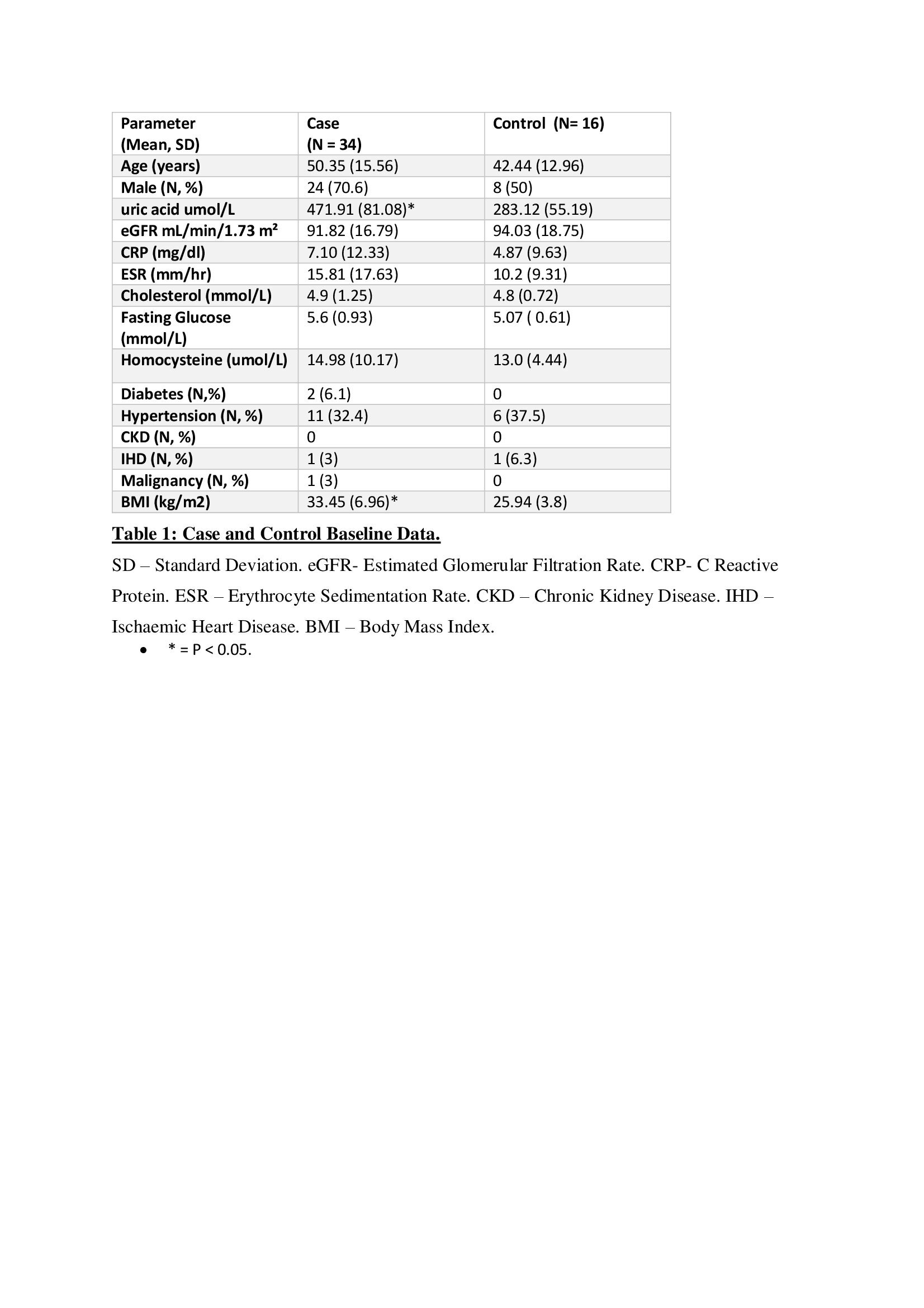Session Information
Date: Tuesday, November 9, 2021
Title: Metabolic & Crystal Arthropathies – Basic & Clinical Science Poster II (1565–1583)
Session Type: Poster Session D
Session Time: 8:30AM-10:30AM
Background/Purpose: Vascular endothelial cells line the entire circulatory system, these cells have very distinct and unique functions that are paramount to vascular biology. Hyperuricemia has been associated with vascular endothelial dysfunction (ED) in cardiovascular disease. Elevated serum urate (sUA) has been shown to directly impair vascular endothelial cell function through inhibition of nitric oxide. While direct measurement of impaired endothelial-dependent dilation during coronary angiography remains the historical “gold-standard”, other approaches, including the measurement of brachial artery diameter via non-invasive ultrasound imaging, has been validated both as a sensitive predictor and surrogate endpoint in cardiovascular risk reduction interventional studies. Close concordance between these measurements with coronary artery endothelial-dependent vasodilation have been established. Our objective was to compare vascular endothelial cell function in hyperuricemic patients with normouricemic controls via flow mediated dilatation (FMD) and nitroglycerin mediated dilatation (NMD) of the brachial artery and the subsequent effect of treatment with urate lowering therapy (ULT).
Methods: Following informed consent hyperuricemic individuals (N = 34) underwent FMD and NMD studies of the brachial artery. Results were compared to age and sex matched normouricemic controls (N=16). Changes in brachial artery diameter were expressed as percentage change relative to the baseline vessel diameter. Those who met the criteria for commencement of ULT underwent repeat studies after a period of three months (N=28) treatment with febuxostat or allopurinol.
Results: 34 patients with hyperuricemia (sUA > 380umol/L) and 16 normouricemic controls were recruited and consented for the study. Mean sUA was 472 and 283 umol/L in the case versus control group respectively. There was no significant difference in mean age (Mean± SD) (50.35± 15.56 v 42.44±12.96) estimated glomerular filtration rate ml/min/1.73m² (91.82± 16.79 v 94.03±18.75 ) or total cholesterol (4.86± 1.25 v 4.73±0.72) between cases and controls respectively however there was a significantly greater (P< 0.05) BMI kg/m2 (33.45± 6.9 v 25.94±3.8) in cases. Cases had significantly impaired (P< 0.05) FMD (11.05± 8.71 v 17.26±8.42) and NMD (19.56± 9.15 v 34.16±9.26) when compared with controls. 28 cases underwent treatment with ULT and repeat FMD and NMD studies post 3 months of therapy, there was a trend toward improved of NMD (22.95 ±7.04) but this was not significant.
Conclusion: These results suggest that hyperuricemia is associated with impaired vascular endothelial dysfunction which may contribute to the increased risk of cardiovascular disease in this cohort of patients.
To cite this abstract in AMA style:
Flood R, Kirby C, Kane D, Mullan R. Hyperuricemia Is Associated with Vascular Endothelial Dysfunction – the Impact of Hyperuricemia on Flow Mediated and Nitroglycerin Mediated Dilatation of the Brachial Artery [abstract]. Arthritis Rheumatol. 2021; 73 (suppl 9). https://acrabstracts.org/abstract/hyperuricemia-is-associated-with-vascular-endothelial-dysfunction-the-impact-of-hyperuricemia-on-flow-mediated-and-nitroglycerin-mediated-dilatation-of-the-brachial-artery/. Accessed .« Back to ACR Convergence 2021
ACR Meeting Abstracts - https://acrabstracts.org/abstract/hyperuricemia-is-associated-with-vascular-endothelial-dysfunction-the-impact-of-hyperuricemia-on-flow-mediated-and-nitroglycerin-mediated-dilatation-of-the-brachial-artery/

